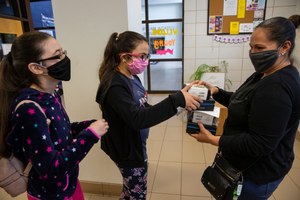
Schools and libraries can apply for funding between June 29 and August 13, 2021
The Emergency Connectivity Fund (ECF) provides $7.17 billion to schools and libraries for remote learning needs. This funding program is administered by the same agency that operates e-Rate, the Universal Service Administrative Company (USAC). (Find out more about e-Rate funding here.)
If a school or library is eligible to receive e-Rate funds, they are eligible to receive funds from the ECF. However, it is not necessary to be currently receiving e-Rate funds to apply for the ECF grant. Per USAC, requirements to apply include an active Federal Communications Commission (FCC) registration number and a current SAM.gov registration.
Schools and libraries can apply between June 29, 2021 and August 13, 2021. Allowable services and equipment can be purchased with this funding between July 1, 2021 and June 30, 2022. For more application information, check out emergencyconnectivityfund.org.
The six steps to apply for funding are (USAC):
Allowable expenses include the following to support remote learning for students, education staff and library customers who don’t have enough internet capability to access educational programs provided online during the COVID-19 health crisis. Costs must be reasonable.
Per the Federal Communications Commission, “In limited circumstances where a school or library can demonstrate that there are no available service options sufficient to support remote learning for its students, school staff, or library patrons, the Emergency Connectivity Fund Program may support the construction of new networks and the equipment needed for datacasting services.”
Laptops and tablets purchased for students MUST maintain Children’s Internet Protection Act (CIPA) compliance. This includes having an internet safety policy, monitoring student activity online, protecting minors from harmful pornography or other dangerous activities online, and education about issues such as cyberbullying.
The FCC estimates that 17 million young people in the United States go without the broadband access they require to succeed in online learning.
FCC Acting Chairwoman Jessica Rosenworcel states, “For too long, the Homework Gap has been a troubling and persistent digital equity problem in the United States. With classes themselves moving online and the pandemic requiring us to stay home, we went from having millions of children who couldn’t do online homework assignments to having millions of children who couldn’t do schoolwork at all. In other words, the Homework Gap became a full-fledged learning and education gap. It’s important that we address this issue now, and the Emergency Connectivity Fund gives us the opportunity to do that.”
The ECF grant is a chance for schools and libraries to make Wi-Fi available to all individuals in communities who cannot afford it, especially in rural areas where Wi-Fi services are lacking. Don’t miss this golden funding opportunity to equip students for remote learning success and for American communities to catch up with other countries via technology.
Copyright © 2024 GovGrantsHelp.com. All rights reserved.
